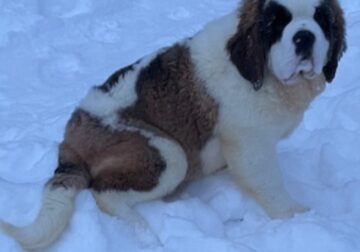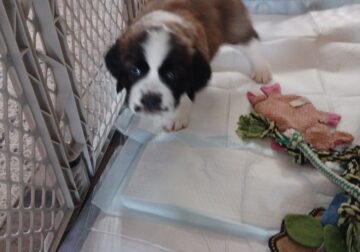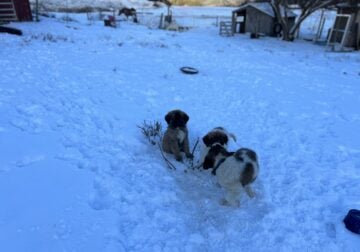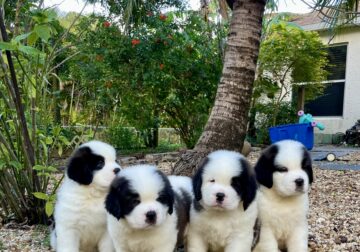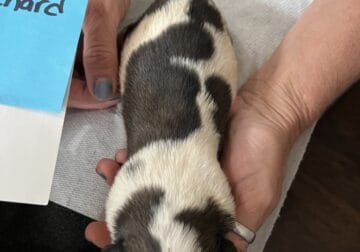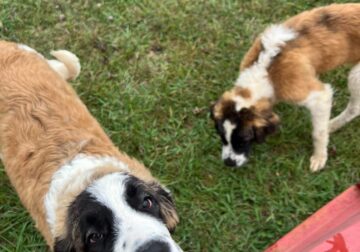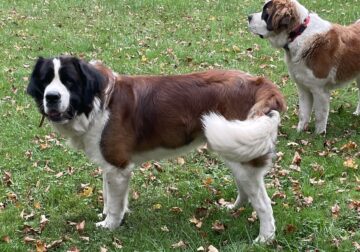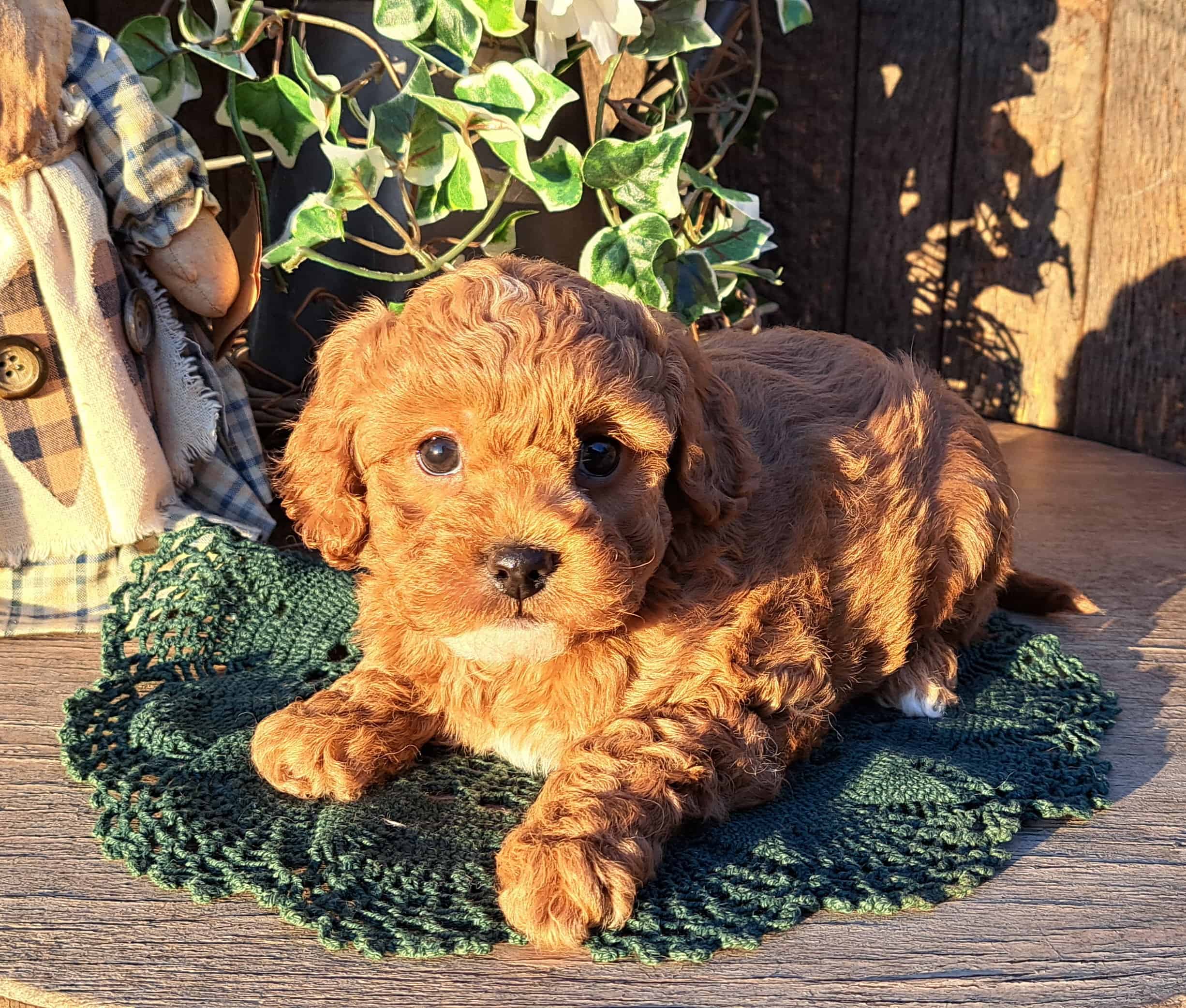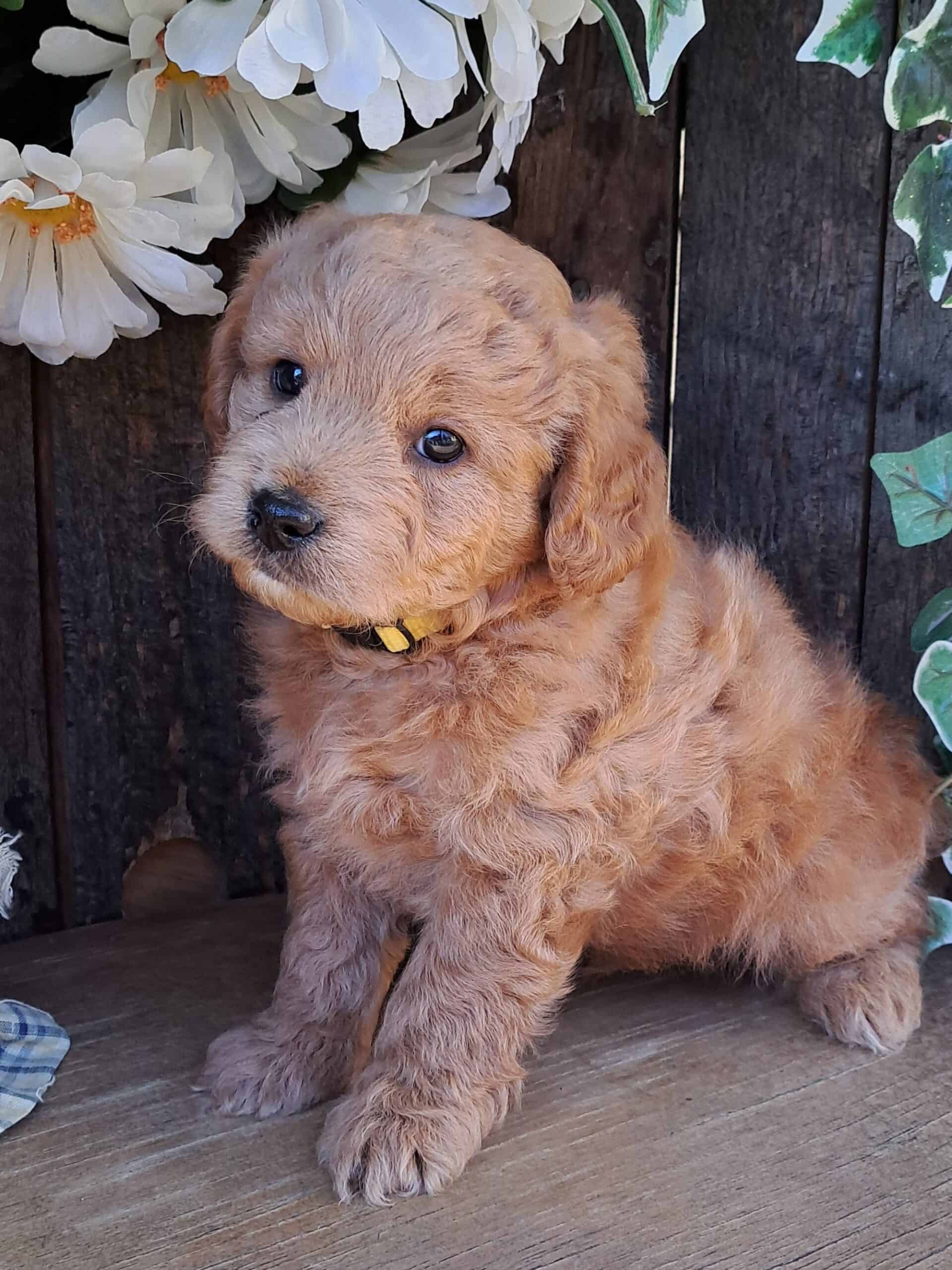Popular Filters:
Saint Bernard puppies for sale under $300
Saint Bernard puppies for sale under $600
Saint Bernard Puppies for Sale: Bringing Out Gentle in Giants
Despite popular movies and adorable animations, giant-breed dogs are not ideal for every family. A case in point is the St Bernard with its striking and impressive appearance but stubborn nature. Massive in size and territorial, a Saint Bernard for sale only makes sense for those dedicated to its extensive upkeep and training needs.
Overview of St Bernard
The Saint Bernard is a giant-sized mastiff-type mountain dog that stands 26 to 35 inches tall at the shoulder and weighs 120 to 200 pounds. Major registries vary in preferable sizes according to their location. The AKC prefers males to be at least 27.5 inches tall and females a minimum of 25.5 inches in height. In contrast, the UKC deems the ideal St Bernard should be 28 to 30 inches tall. It will disqualify any dog that is 2.5 inches outside of this standard. Like the Swiss registry, the FCI sets the acceptable height for dogs between 70 and 90 cm (27.6 to 35.5 inches) and that for bitches between 65 and 80 cm (25.6 to 31.5 inches). The FCI does not penalize Saint Bernards that are above the maximum height standards if their proportions are in balance.
History
Bernard of Menthos was an Italian monk who built a hospice at St Nicholas Pass in the Alps along one of the borders between Italy and Switzerland. The hospice, established around 1050, became the site of breeding guard dogs in the 1660s. By the 1690s, the breed’s founders saw the advantage of using these large-sized, powerful dogs for mountain rescues. The St Bernard transformed from a cross-breed to a consistent type around 1709, although it went by names like the Saint Dog, Barry Dog, or Noble Steed. Eventually, the dog, pass, and hospice were named after Bernard.
Rescue from Extinction
Saint Bernards suffered a significant setback between 1816 and 1818 when an increase in avalanches decimated a large number of them. Those interested in preserving the Saint Bernard crossed the few remaining specimens with Newfoundlands in the 1860s, and the breed would never be the same. The Newfoundland coat, more suited to water than snow, removed the new hybrid’s effectiveness as a mountain rescue dog. The last St Bernard rescue on record was in 1897. Fanciers eventually sought a more massive dog in the St Bernard and continued influencing its structure by introducing breeds like the Great Pyrenees, English Mastiff, Great Dane, and Greater Swiss Mountain Dog as well as more Newfoundlands. It resulted in a dog that lies between the English Mastiff and livestock guardian dog in appearance and size.
American Kennel club
Saint Bernards first arrived in America in the early 1860s. The AKC recognized the breed in 1885. While quite popular in the UK, the St Bernard ranks only 52 out of 195 dog breeds in the US as of 2021.
Personality
In mastiff-type fashion, St Bernards are calm, friendly, and tolerant. They tend to be gentle, although their large size still makes them a poor fit with young children and toddlers. Young dogs can be quite rambunctious. St Bernards are moderately territorial and protective of their families like others in the Mastiff family. Poorly-socialized individuals can become vicious. The disposition of a St Bernard should set it up to be an intimidating watchdog rather than an attack dog. A Saint Bernard for sale generally gets along with other animals, from horses to cats. The key, again, is extensive socialization of your pup from a young age. The only snag is a St Bernard’s size can leave small dogs vulnerable to severe accidental injuries during play.
Conformation
A Saint Bernard for sale has a massive head and a short but deep muzzle. The cheekbones are highly-developed, and the stop is steep and abrupt. The brows are pronounced and partially account for the deep furrow that exists between the eyes. Wrinkles must be present on the forehead but are not exaggerated. The eyes are medium-sized, deep-set, and forward-facing. You will notice medium-sized, high-set ears that are slightly elongated triangles with rounded tips. They stand off from the head at the base but then form an angle to lie against the face. There is an indentation between the head and neck. The latter is powerful and allows for a high-head carriage. Saint Bernards are broad in the back, shoulders, and rump. They have a level topline and a slight slope to the croup. The chest is broad and only moderately deep. There is a slight abdominal uptuck from the sternum to the hips. The shoulders, limbs, and haunches are exceptionally muscular. The tail arises in a natural line from the croup and hangs straight with a slight upward curve. It is thick and does not taper much towards the tip. Dogs frequently elevate their tails when excited, but it should not rise above the level of the back.
Coat
Saint Bernard puppies for sale can have two coat types. Both variants have very dense fur that still lies flat. You will also see a swath of longer hair or a burr at the base of the ears. Short-haired St Bernards have thick, bushier hair on the backs of the upper hind legs. The hair on the back and the base of the tail is slightly longer than that on the rest of the body, and you may notice a slight wave. Long-haired dogs have medium-length, wavy fur. The fur is notably longer on the neck and back. The forelegs have light feathering while the backs of the thighs have thick breeches. The tail is heavily bushed but should not have extensive plumes.
Colors
The St Bernard is notable in that it is the only Swiss mountain dog that is not tri-colored in the classic sense (black & brown with white markings). Saint Bernards are white with various shades and patterns of brown or red. Two major patterns are splash-coated and mantle which are descriptive terms. A splash-coated dog has patches of color that may look irregular or splattered. Mantle dogs look like they are wearing a blanket, usually having a large continuous area of a solid color over the back and down the sides. Such dogs should still have white markings on their face, as a collar around their neck (can also be a spot), and on their chest, feet, and the tip of their tail.
- White with brindle patches
- Red & white or white & red
- Orange & white or white & orange
- Mahogany & white or white & mahogany
- Rust & white or white & rust
- Brown & white or white & brown
Regardless of their color shade or distribution, the AKC prefers dogs with a partial black facial mask and dark shading on the ears.
Saint Bernard Puppies for Sale Near Me
By the time a Saint Bernard puppy is ready to go to a new home, it already likely weighs 30 to 50 pounds. If you find a local litter of Saint Bernard puppies for sale, you should visit and find pups that look massive and well-fed. They should also be alert and free from soiling and evidence of disease. This means no diarrhea stains on the hind end and no discharge from the eyes or nose. Young puppies should be friendly and curious about your presence. Hopefully, you can also see one of the parents. It will give you an idea about what to expect from your pup in terms of size and disposition when it matures.
Lifespan
As is typical of a giant breed, St Bernards only live seven to ten years.
Care
St Bernards require more care than many dogs because of their sheer size.
Grooming
Saint Bernards have the basic grooming needs of any dog.
- Nail trim – every four to six weeks; thick and strong nails may require professional
- Wipe the face – every one or two days
- Check ears daily – watch for scratching and inspect for redness or an abnormal odor or discharge
- Bathe every six to twelve weeks
- Brush – three times a week; long-haired with a pin brush, short-haired with rubber curry or glove
- Clean ears as necessary of excess exudate; can lightly swab the ears when you bathe your dog
Feeding
Regardless of age, you should feed your St Bernard at least two or three times daily to avoid bloat. Puppies may eat four to eight meals a day. Make sure to feed a meat-based diet with moderate fats. Carbohydrates are not necessary, but beneficial choices include green vegetables, squash, and low-sugar fruits like berries. Most adult St Bernards do not work and just need 25 to 28 calories per pound of body weight daily. This works out to approximately nine to fifteen cups of dry dog food each day. Growing puppies require 2.5 to 3 times the calories of a mature Saint Bernard. Fresh food is cost-prohibitive for many owners as a mature dog would eat 21 to 50 pounds of food, mostly meat, every week.
Exercise
A St Bernard has moderate exercise requirements of 30 to 45 minutes a day. While 20% should be intense, the remainder can be light or center around training and other mentally stimulating activities. Puppies require consistent training and should not engage in structured exercises over 20 minutes in duration until they are mature. This could take over 18 months. While St Bernards are very tolerant of cold weather, you should avoid exercising them if it is hot or humid outside. Maximum tolerable temperatures for a St Bernard are between 80 and 83 degrees Fahrenheit.
Training
While St Bernards are emotionally and intuitively smart, they rank below average in working intelligence. This means you must begin training your puppy as soon as possible and make heavy use of repetitions. Most St Bernards respond positively to a reward-based system of training, but they still have plenty of times where they are strong-headed. Your main goal should be to establish training basics before your dog realizes her strength.
